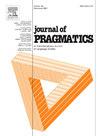From words to multimodalities: Compliment perceptions across lingua cultures
IF 1.7
1区 文学
0 LANGUAGE & LINGUISTICS
引用次数: 0
Abstract
While compliments have been widely studied through various methods, recipient perceptions in multimodal contexts remain insufficiently explored. Multimodal cues, such as intonation, gestures, and facial expressions, may play a crucial role in shaping compliment perception, yet these factors lack systematic analysis. To address this gap, this study examines how compliments are perceived across different modalities using the Modal Incremental Perception Method (MIP). Specifically, it investigates how 362 native speakers of English, Swiss German, and Chinese perceive the same compliments in four modes: text-only, text with emojis, audio, and multimodal video. Through online experiments and retrospective interviews, this study explores multiple dimensions of compliment perception, including sincerity, politeness, appropriateness, likeability, and pleasantness, along with participants' reasoning for their evaluations. The quantitative results show that lingua culture significantly influences perceptions of the four forms of compliments to varying degrees, with the inclusion of multimodal information affecting compliment perceptions across lingua culture groups. Additionally, the qualitative analysis shows that participants’ reasons for compliment perceptions are influenced by both lingua culture and individual differences. Overall, this study shifts the analytical focus from compliment production to perception and provides a multidimensional perspective on compliments, therefore advancing speech act research from the perspective of compliments.
从单字到多模态:跨语言文化的赞美认知
虽然人们已经通过各种方法对赞美进行了广泛的研究,但对多模态语境下接受者的认知仍未进行充分的探索。语调、手势和面部表情等多模态线索可能在形成赞美感知方面起着至关重要的作用,但这些因素缺乏系统的分析。为了解决这一差距,本研究使用模态增量感知方法(MIP)研究了如何在不同的模态中感知赞美。具体来说,它调查了362名母语为英语、瑞士德语和汉语的人如何在四种模式下感知相同的赞美:纯文本、带表情符号的文本、音频和多模式视频。通过在线实验和回顾性访谈,本研究探讨了赞美感知的多个维度,包括真诚、礼貌、适当、可爱和愉快,以及参与者对其评价的推理。定量结果表明,语言文化在不同程度上显著影响着人们对四种赞美形式的认知,其中包含的多模态信息影响着不同语言文化群体对赞美的认知。此外,定性分析表明,参与者对赞美感知的原因受到语言文化和个体差异的影响。总体而言,本研究将分析重点从恭维语的产生转移到恭维语的感知,提供了一个多维度的恭维语视角,从而推动了恭维语视角下的言语行为研究。
本文章由计算机程序翻译,如有差异,请以英文原文为准。
求助全文
约1分钟内获得全文
求助全文
来源期刊

Journal of Pragmatics
Multiple-
CiteScore
3.90
自引率
18.80%
发文量
219
期刊介绍:
Since 1977, the Journal of Pragmatics has provided a forum for bringing together a wide range of research in pragmatics, including cognitive pragmatics, corpus pragmatics, experimental pragmatics, historical pragmatics, interpersonal pragmatics, multimodal pragmatics, sociopragmatics, theoretical pragmatics and related fields. Our aim is to publish innovative pragmatic scholarship from all perspectives, which contributes to theories of how speakers produce and interpret language in different contexts drawing on attested data from a wide range of languages/cultures in different parts of the world. The Journal of Pragmatics also encourages work that uses attested language data to explore the relationship between pragmatics and neighbouring research areas such as semantics, discourse analysis, conversation analysis and ethnomethodology, interactional linguistics, sociolinguistics, linguistic anthropology, media studies, psychology, sociology, and the philosophy of language. Alongside full-length articles, discussion notes and book reviews, the journal welcomes proposals for high quality special issues in all areas of pragmatics which make a significant contribution to a topical or developing area at the cutting-edge of research.
 求助内容:
求助内容: 应助结果提醒方式:
应助结果提醒方式:


